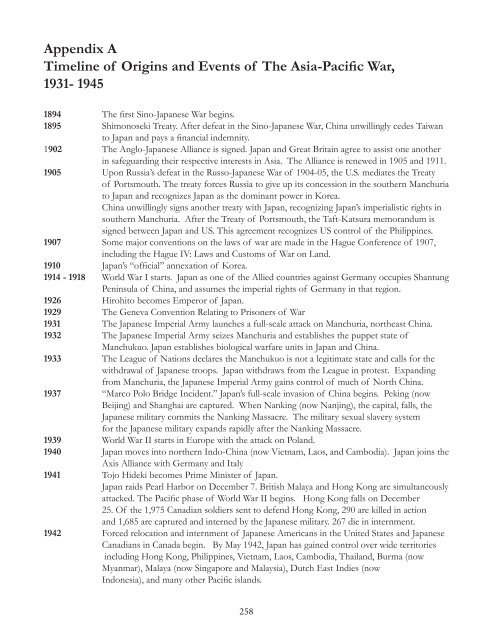Download - Canada ALPHA
Download - Canada ALPHA
Download - Canada ALPHA
You also want an ePaper? Increase the reach of your titles
YUMPU automatically turns print PDFs into web optimized ePapers that Google loves.
Appendix A<br />
Timeline of Origins and Events of The Asia-Pacifi c War,<br />
1931- 1945<br />
1894 The fi rst Sino-Japanese War begins.<br />
1895 Shimonoseki Treaty. After defeat in the Sino-Japanese War, China unwillingly cedes Taiwan<br />
to Japan and pays a fi nancial indemnity.<br />
1902 The Anglo-Japanese Alliance is signed. Japan and Great Britain agree to assist one another<br />
in safeguarding their respective interests in Asia. The Alliance is renewed in 1905 and 1911.<br />
1905 Upon Russia’s defeat in the Russo-Japanese War of 1904-05, the U.S. mediates the Treaty<br />
of Portsmouth. The treaty forces Russia to give up its concession in the southern Manchuria<br />
to Japan and recognizes Japan as the dominant power in Korea.<br />
China unwillingly signs another treaty with Japan, recognizing Japan’s imperialistic rights in<br />
southern Manchuria. After the Treaty of Portsmouth, the Taft-Katsura memorandum is<br />
signed between Japan and US. This agreement recognizes US control of the Philippines.<br />
1907 Some major conventions on the laws of war are made in the Hague Conference of 1907,<br />
including the Hague IV: Laws and Customs of War on Land.<br />
1910 Japan’s “offi cial” annexation of Korea.<br />
1914 - 1918 World War I starts. Japan as one of the Allied countries against Germany occupies Shantung<br />
Peninsula of China, and assumes the imperial rights of Germany in that region.<br />
1926 Hirohito becomes Emperor of Japan.<br />
1929 The Geneva Convention Relating to Prisoners of War<br />
1931 The Japanese Imperial Army launches a full-scale attack on Manchuria, northeast China.<br />
1932 The Japanese Imperial Army seizes Manchuria and establishes the puppet state of<br />
Manchukuo. Japan establishes biological warfare units in Japan and China.<br />
1933 The League of Nations declares the Manchukuo is not a legitimate state and calls for the<br />
withdrawal of Japanese troops. Japan withdraws from the League in protest. Expanding<br />
from Manchuria, the Japanese Imperial Army gains control of much of North China.<br />
1937 “Marco Polo Bridge Incident.” Japan’s full-scale invasion of China begins. Peking (now<br />
Beijing) and Shanghai are captured. When Nanking (now Nanjing), the capital, falls, the<br />
Japanese military commits the Nanking Massacre. The military sexual slavery system<br />
for the Japanese military expands rapidly after the Nanking Massacre.<br />
1939 World War II starts in Europe with the attack on Poland.<br />
1940 Japan moves into northern Indo-China (now Vietnam, Laos, and Cambodia). Japan joins the<br />
Axis Alliance with Germany and Italy<br />
1941 Tojo Hideki becomes Prime Minister of Japan.<br />
Japan raids Pearl Harbor on December 7. British Malaya and Hong Kong are simultaneously<br />
attacked. The Pacifi c phase of World War II begins. Hong Kong falls on December<br />
25. Of the 1,975 Canadian soldiers sent to defend Hong Kong, 290 are killed in action<br />
and 1,685 are captured and interned by the Japanese military. 267 die in internment.<br />
1942 Forced relocation and internment of Japanese Americans in the United States and Japanese<br />
Canadians in <strong>Canada</strong> begin. By May 1942, Japan has gained control over wide territories<br />
including Hong Kong, Philippines, Vietnam, Laos, Cambodia, Thailand, Burma (now<br />
Myanmar), Malaya (now Singapore and Malaysia), Dutch East Indies (now<br />
Indonesia), and many other Pacifi c islands.<br />
258


